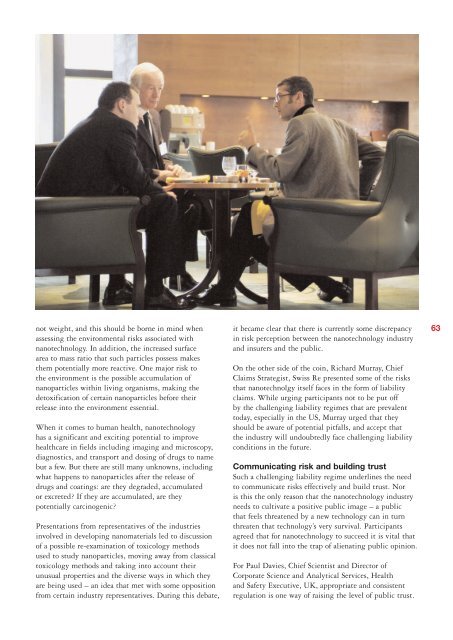Small size - large impact - Nanowerk
Small size - large impact - Nanowerk
Small size - large impact - Nanowerk
Create successful ePaper yourself
Turn your PDF publications into a flip-book with our unique Google optimized e-Paper software.
not weight, and this should be borne in mind when<br />
assessing the environmental risks associated with<br />
nanotechnology. In addition, the increased surface<br />
area to mass ratio that such particles possess makes<br />
them potentially more reactive. One major risk to<br />
the environment is the possible accumulation of<br />
nanoparticles within living organisms, making the<br />
detoxification of certain nanoparticles before their<br />
release into the environment essential.<br />
When it comes to human health, nanotechnology<br />
has a significant and exciting potential to improve<br />
healthcare in fields including imaging and microscopy,<br />
diagnostics, and transport and dosing of drugs to name<br />
but a few. But there are still many unknowns, including<br />
what happens to nanoparticles after the release of<br />
drugs and coatings: are they degraded, accumulated<br />
or excreted? If they are accumulated, are they<br />
potentially carcinogenic?<br />
Presentations from representatives of the industries<br />
involved in developing nanomaterials led to discussion<br />
of a possible re-examination of toxicology methods<br />
used to study nanoparticles, moving away from classical<br />
toxicology methods and taking into account their<br />
unusual properties and the diverse ways in which they<br />
are being used – an idea that met with some opposition<br />
from certain industry representatives. During this debate,<br />
it became clear that there is currently some discrepancy<br />
in risk perception between the nanotechnology industry<br />
and insurers and the public.<br />
On the other side of the coin, Richard Murray, Chief<br />
Claims Strategist, Swiss Re presented some of the risks<br />
that nanotechnolgy itself faces in the form of liability<br />
claims. While urging participants not to be put off<br />
by the challenging liability regimes that are prevalent<br />
today, especially in the US, Murray urged that they<br />
should be aware of potential pitfalls, and accept that<br />
the industry will undoubtedly face challenging liability<br />
conditions in the future.<br />
Communicating risk and building trust<br />
Such a challenging liability regime underlines the need<br />
to communicate risks effectively and build trust. Nor<br />
is this the only reason that the nanotechnology industry<br />
needs to cultivate a positive public image – a public<br />
that feels threatened by a new technology can in turn<br />
threaten that technology’s very survival. Participants<br />
agreed that for nanotechnology to succeed it is vital that<br />
it does not fall into the trap of alienating public opinion.<br />
For Paul Davies, Chief Scientist and Director of<br />
Corporate Science and Analytical Services, Health<br />
and Safety Executive, UK, appropriate and consistent<br />
regulation is one way of raising the level of public trust.<br />
63
















